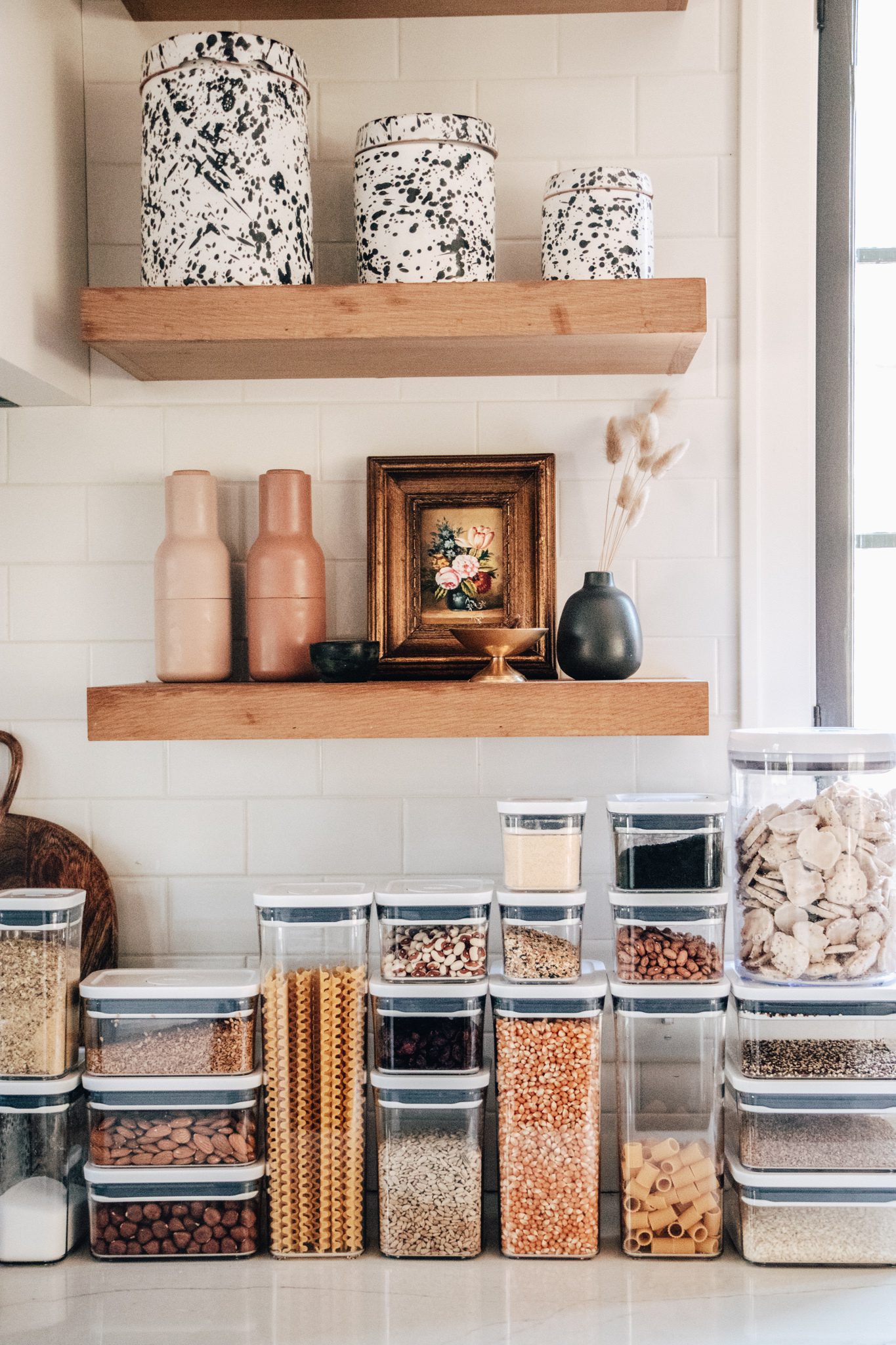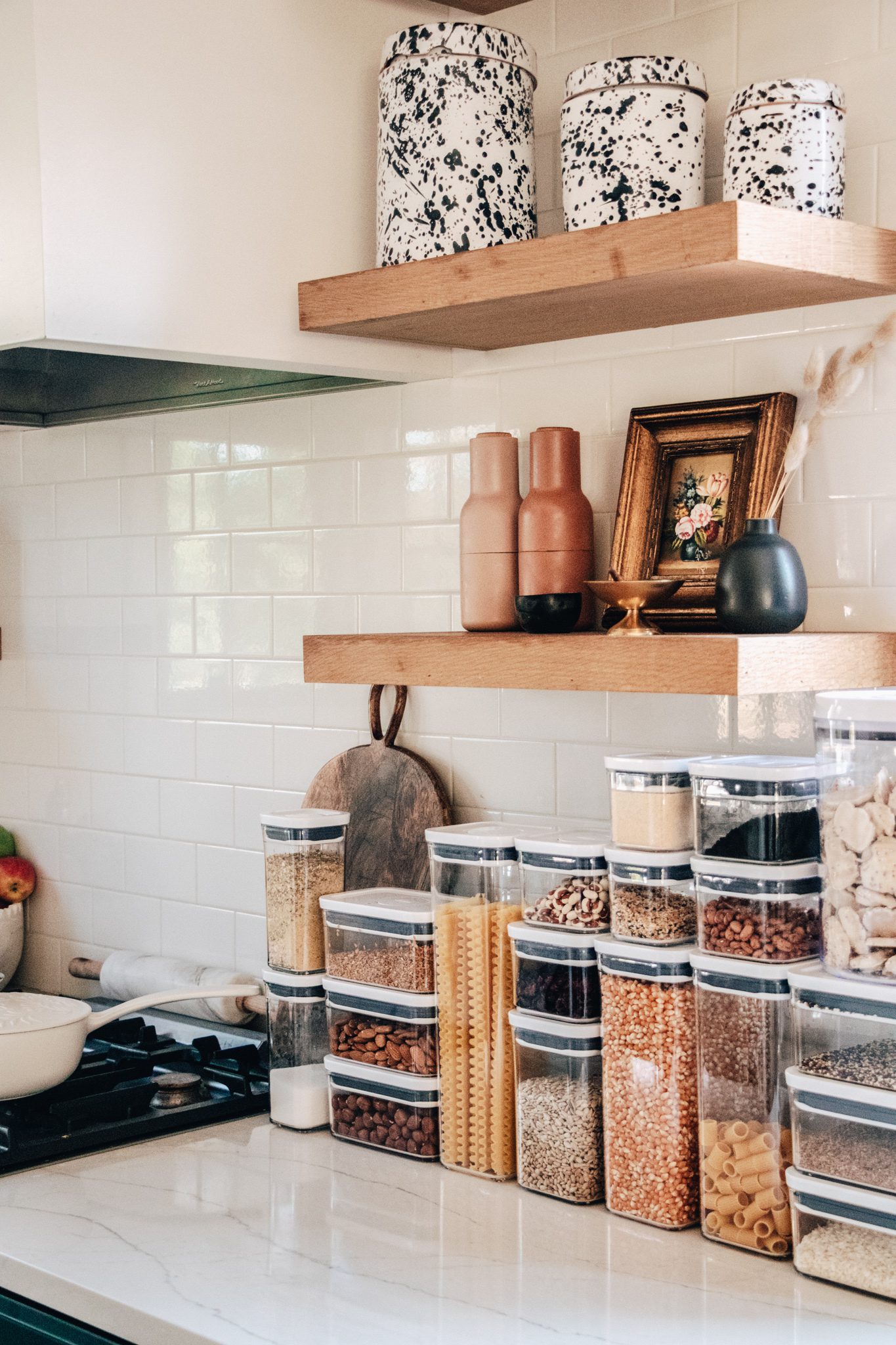
Editor’s Note: As the weather cools down in our neck of the woods, many of us are finding ourselves cooking at home with more frequency. This article, originally published in May 2020, is full of pantry organization tips to help you make the most of the ingredients you have on hand.
When I think about the kind of cook I want to be, I imagine myself effortlessly moving through the kitchen, surveying what I have on hand, and then whipping up some kind of original recipe simply because the greens were about to wilt. There is something so satisfying about using all the food you bring into your house, and being a good enough cook to make your grocery bill stretch further isn’t as difficult as it might seem. We might not be floating through the kitchen like we’re Padma from Top Chef but we can set ourselves up for success.
Today I’m sharing exactly how I keep my pantry stocked and organized, including a complete list of the items I have on hand and how I manage inventory as certain items begin to dwindle.
How to Organize Your Pantry
1. Clean EVERYTHING out and put it where you can see it.
Wipe down the drawers, cabinets, everything. A pantry isn’t a one size fits all kind of place in the home. It can be a cupboard, a shelf—wherever you keep the items that you refer back to again and again when cooking at home. Throw away anything that has moved way beyond the expiration date.
2. Group items together using the list below.
I keep canned goods together, spices together, and baking ingredients in one spot. Then I have a designated spot for oils and vinegars, beans and rice, and pasta.
3. Make it visual.
Half the battle when it comes to a well-organized pantry is that you know where everything is and where to put each item when you are done cooking. Creating a visually appealing pantry is a great motivator for some, but it may only keep you motivated until the newness wears off.
Think about organizing items so it’s as easy as possible to spot what you need, retrieve the ingredient, and put it back. Some people take this as an opportunity to repurpose old jars they’ve been saving and to start with a fresh bulk system, which I recommend. We use OXO Pop containers to store our pantry items and love how easy they are to stack and how well they keep food fresh. If you are storing food in separate containers, I’d recommend writing down the date you add ingredients to your jars (and expiration dates when applicable), so you can know when it’s time to toss old ingredients.
How to Stock Your Pantry
Below, I’m sharing a list of everything we keep in our pantry. Yes, the list includes items you’ll store in your fridge and freezer, too. I realize “pantry” cooking is more about keeping a running inventory of items that don’t need to be replaced weekly like fresh veggies and meat, but I like to keep track of every ingredient I regularly use when cooking. Restocking the kitchen becomes a lot less complicated when you know you already have a baseline list of ingredients you can rely on when you’re about to be over budget OR can’t get to the market.
When thinking about how to stock your pantry, keep in mind that you don’t need (and may not want) every ingredient on our list, especially if you are just starting out. Think about the ingredients you use the most, begin using your newly organized pantry, make it a habit to put things back where you found them, slowly add in more ingredients as you begin to expand your base knowledge of cooking, and pick recipes that help you build your pantry as you go.

Exactly What We Keep in Our Pantry
Fridge
- Bacon and/or pancetta
- Parmigiano
- Mozzarella/Cheddar
- Feta
- Butter
- Citrus: lemons, limes, oranges
- Mayonnaise
- Mustard
- Ketchup
- Hot sauce
- Eggs
- Fresh chiles
- Ginger
- Jams and preserves
- Maple syrup
- Milk and buttermilk
- Miso
- Nut butter
- Capers
- Olives
- Pickles
- Tahini
- Yogurt and sour cream
Freezer
- Bread, bread crumbs
- Frozen fruit
- Frozen vegetables
- Leftover red and white wine
- Nuts: almonds, hazelnuts, and walnuts
Pantry
- Kosher Salt (Diamond Crystal)
- Finishing Salt (Maldon or Fleur de Sel)
- Black pepper
- Ghee
- Shortening
- Garlic
- Gochujang paste
- Onions and shallots
- Olive oil (for cooking, Kirkland and for finishing, your preferred high-quality brand)
- Soy sauce
- Vinegar: cider, red wine, white wine, rice, sherry
- Canned beans
- Canned whole tomatoes (San Marzano)
- Jarred or canned fish: tuna, anchovies
- Coconut milk
- Dried beans
- Dried fruits
- Dried chiles
- Pasta and rice noodles
- Polenta and grits
- Whole grains, rice, and quinoa
Baking
- Baking soda and baking powder
- Chocolate chips/bars
- Cocoa powder
- Cooking spray
- Cornstarch
- Flour: all-purpose, cake, whole wheat
- Honey
- Molasses
- Sugar: granulated, brown, raw
- Vanilla extract and vanilla beans
Spices
- Bay leaf
- Cardamom
- Cayenne pepper
- Coriander seeds
- Crushed red pepper
- Cumin
- Turmeric
- Fennel seed
- Mustard seeds
- Za’atar spice mix
Download our free Stock the Pantry Checklist (pictured below) to keep track of what’s in your pantry.

How to Manage Your Inventory
Keeping an inventory of what you have on hand is THE secret to cutting your grocery bill down and avoiding food waste. Here are a couple of tips for knowing what you have, how much you have of it, and what you need when it comes time to restock.
1. Keep our handy printout on the fridge, laminated.
When you run low on an ingredient, check the box next to the said ingredient.
2. Reference your list when coupons and offers come into your inbox or mailbox.
You can clip the coupon directly to the list or keep an envelope on your desk to stuff them in so they’re easy to grab when you head to the store.
3. Keep extra stock of nonperishable items in a different location.
Make note of the extra stock with a different colored marker next to the ingredient. Wipe it clean when you’ve used the last box, can, or serving so you know to buy more.
4. Once a month, clean out anything that has expired.
This is a relatively easy task when you keep up with it. It is also a great opportunity to take note of the number of items like frozen meats and veggies that you’ve kept stashed in the freezer. Always keep dates on these items so you can use them within the freezing window and avoid wasting food.

Do you have any advice to add for me and our fellow pantry cooks? I’m all ears.
If you’re ready to get cooking, you’ll find some of our favorite pantry meals in the posts below.
20 Classic, Simple Recipes I Love to Make Over and Over Again
How to Make Cacio e Pepe: The Cooking Process I Swear By Every Time
This French Green Bean Potato Salad Is Perfect for Any Occasion
9 Grown-Up Spins on Your Favorite Childhood Foods
The Best 5-Ingredient Pasta Dish…Ever

Kate is currently learning to play the Ukulele, much to the despair of her husband, kids, and dogs. Follow her on Instagram at @witanddelight_.